Abstract
To characterize the cell(s) responsible for the suppressor-cell dysfunction in active systemic lupus erythematosus (SLE), we fractionated blood mononuclear cells into thymus-derived (T), bone marrow-derived (B), and monocyte-depleted populations. Various cell populations from active SLE, inactive SLE, or normals, were activated with Concanavalin A, washed, and then co-cultured with active SLE cells. Soluble immune response suppressor (SIRS) from culture supernates of the activated cells was also used for the possible correction of the suppressor-cell dysfunction. Suppression was tested by enumerating DNA-binding cells by radioautography and by quantitating anti-DNA antibody in culture supernates by radioimmunoassay; and immunoglobulin was tested in cells and supernates by the immunofluorescence and the immunofluor techniques, respectively. Except for the numbers of DNA-binding cells, which were not suppressed, all the other three parameters in co-cultures with cells from active SLE patients were suppressed by Concanavalin A-activated cells (P < 0.001), or by SIRS (P < 0.05) from normals or inactive SLE patients. Concanavalin A-activated autologous or allogeneic active SLE cells and nonactivated cells from active or inactive SLE failed to suppress the various B-cell functions. Nonactivated normal cells suppressed levels of anti-DNA and immunoglobulin in supernates (P < 0.05).
In characterizing the cells responsible for the suppressor dysfunction, it was clear from the results that T cells responsive to Concanavalin A activation are deficient in active SLE and fail to generate SIRS. On the other hand, monocytes from active SLE patients are responsive to signals from the activated T cells of normals or inactive SLE donors. Because SIRS suppresses active SLE cells in vitro, it might be considered therapeutically for the in vivo modulation of SLE.
Full text
PDF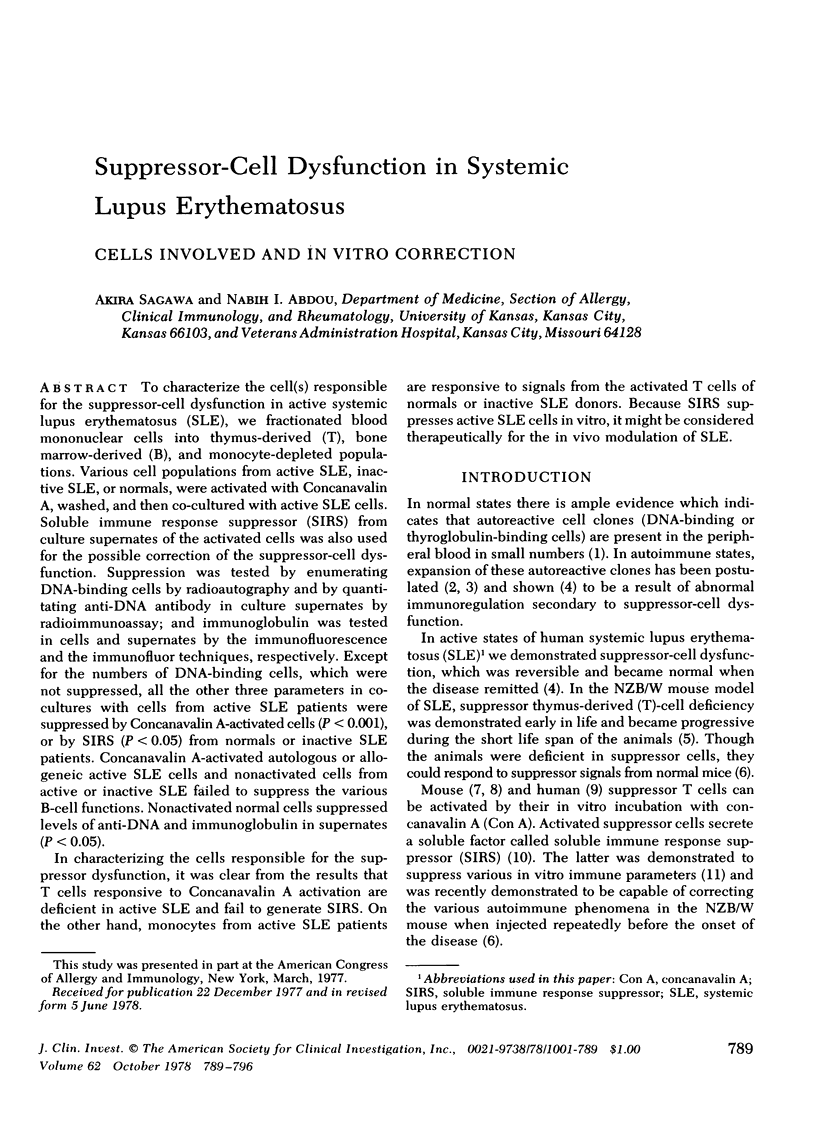
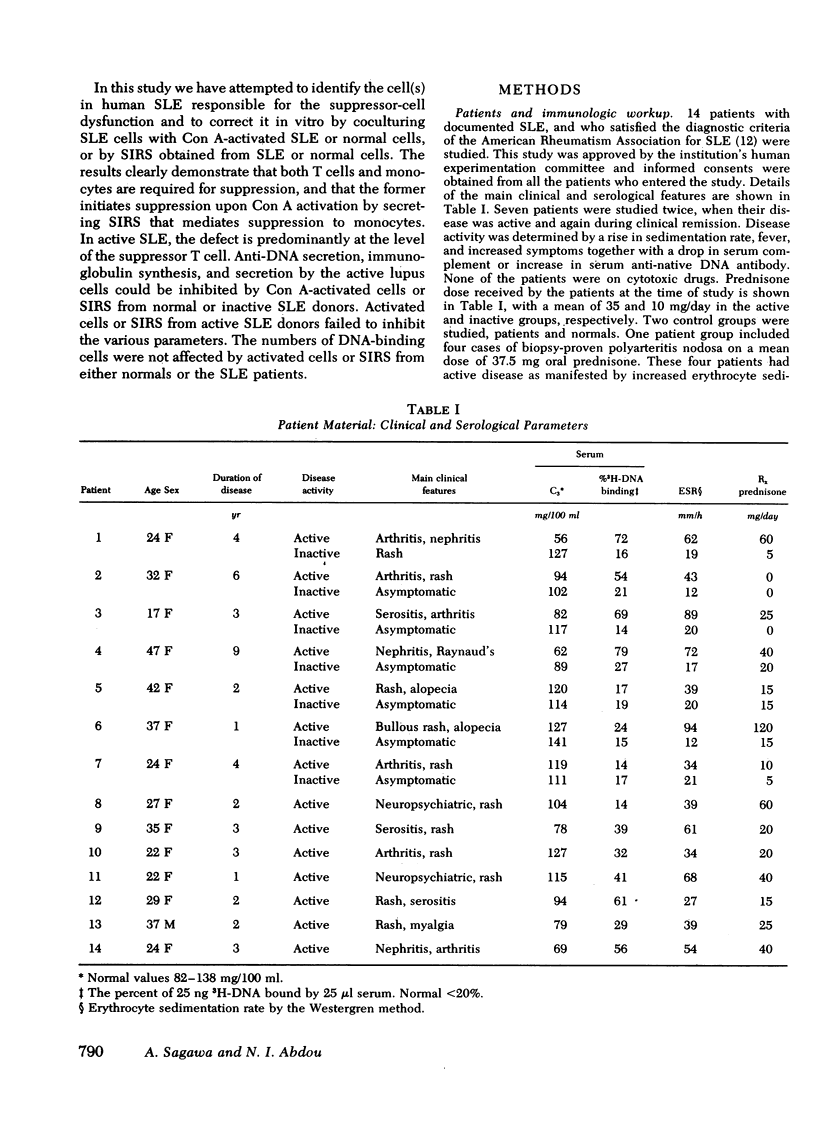
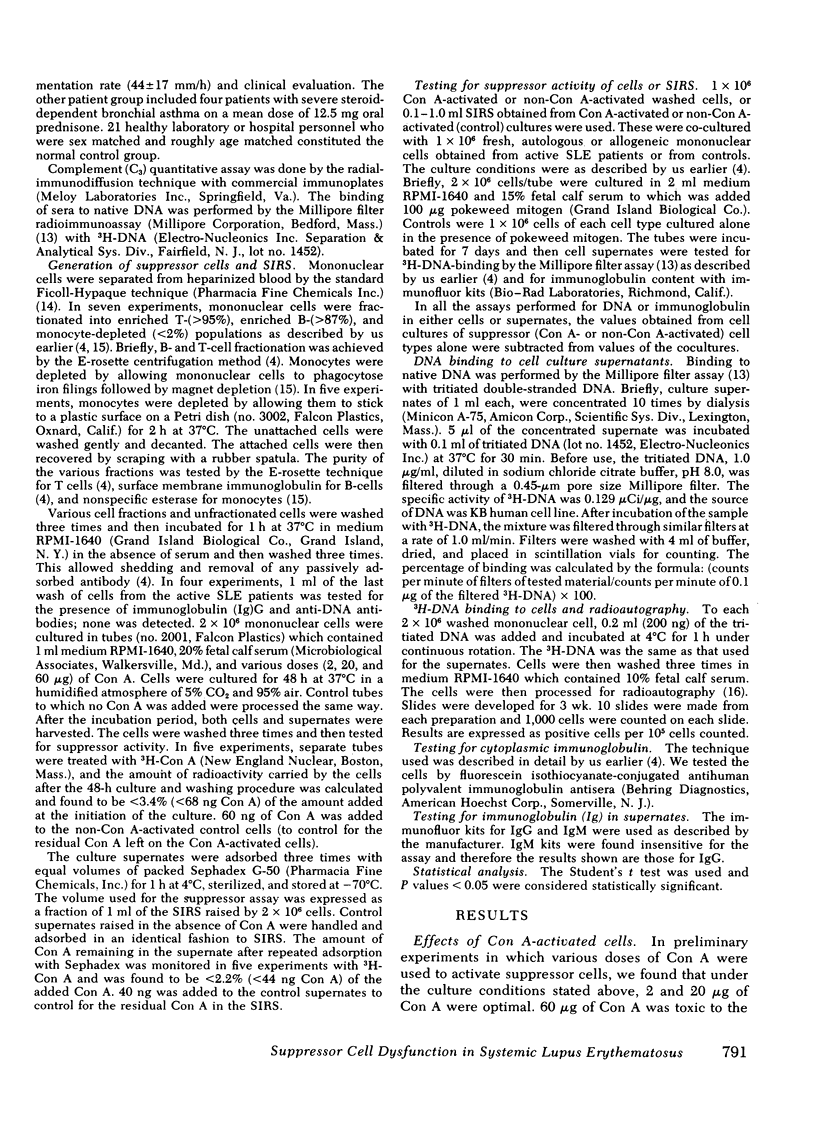
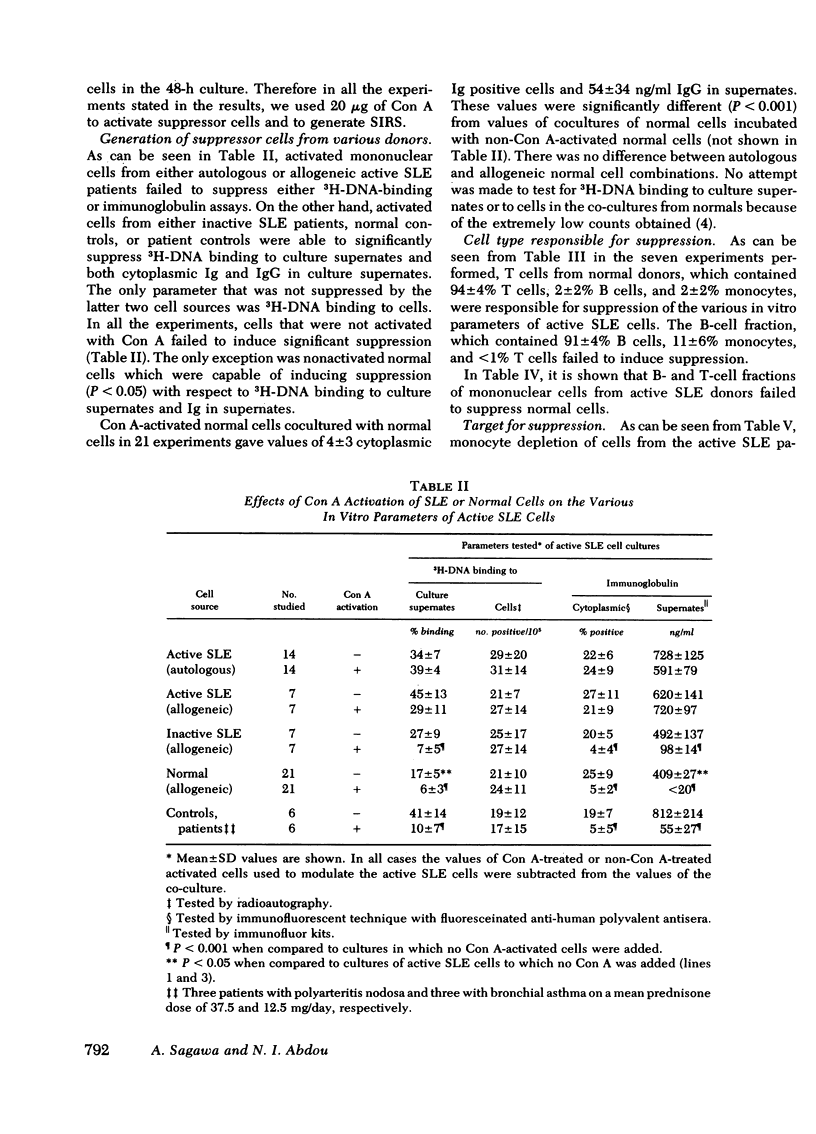
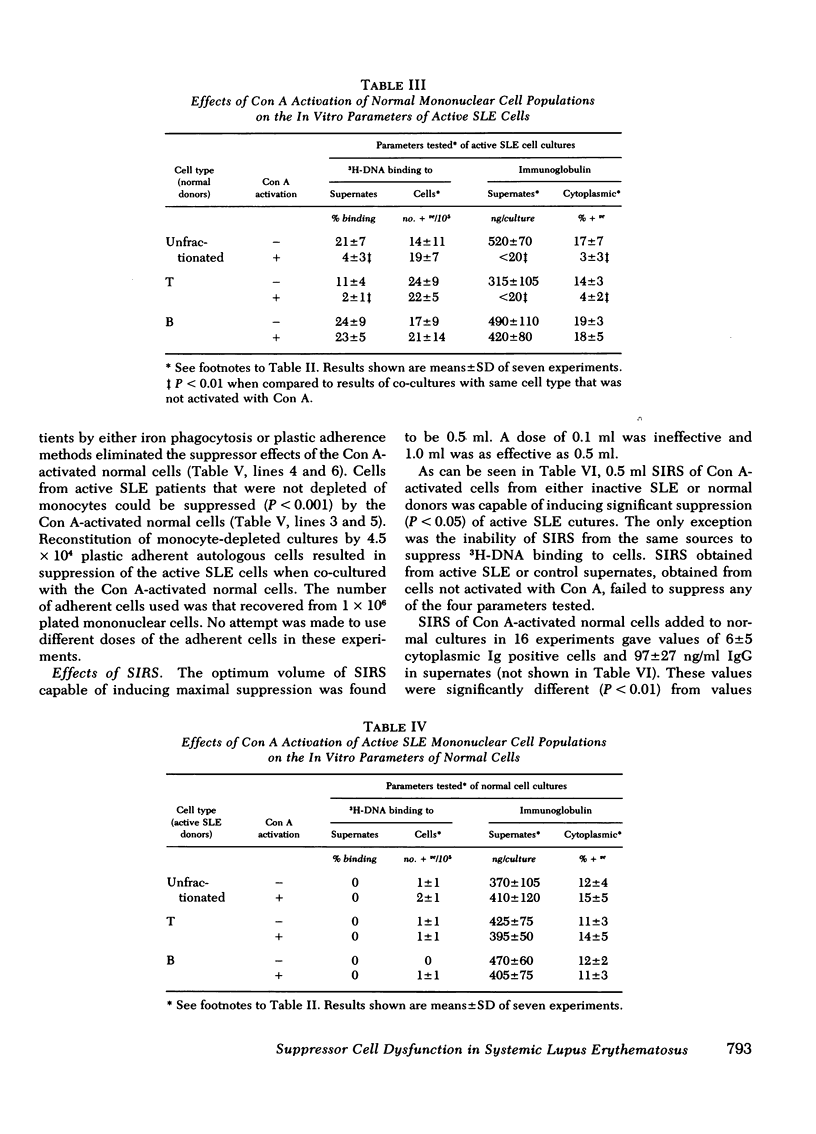
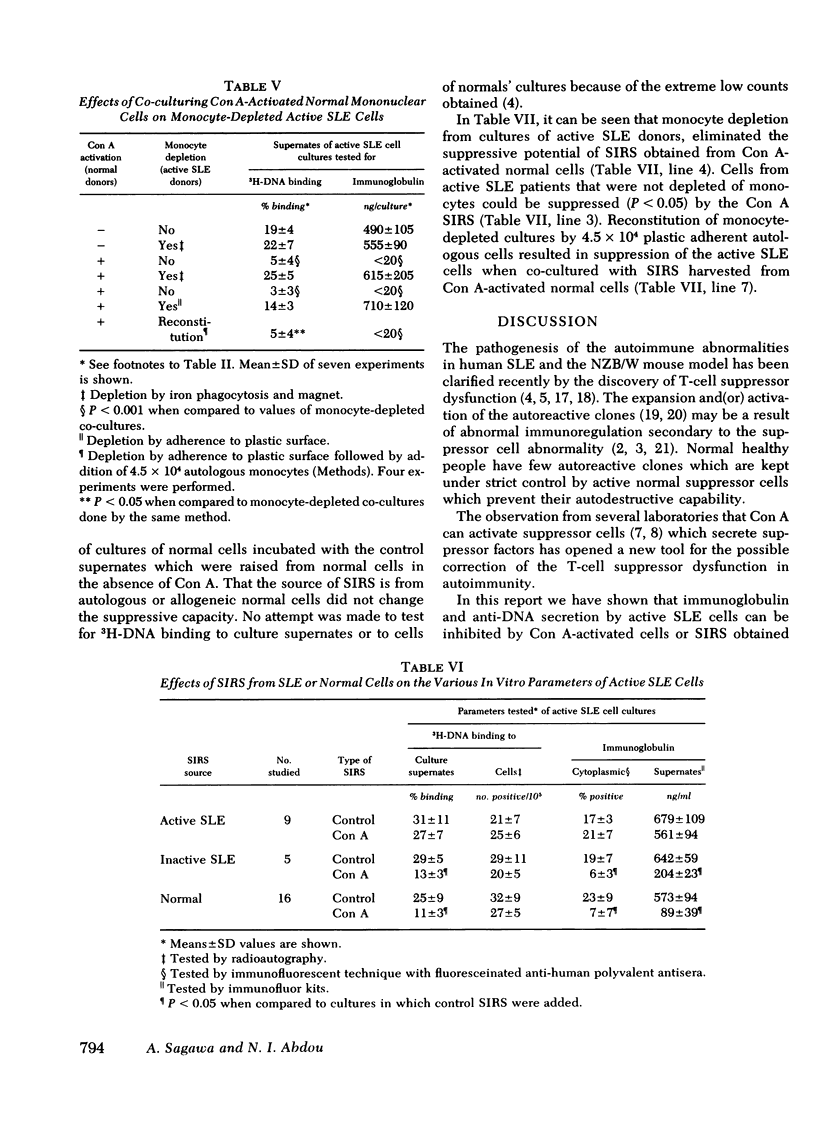

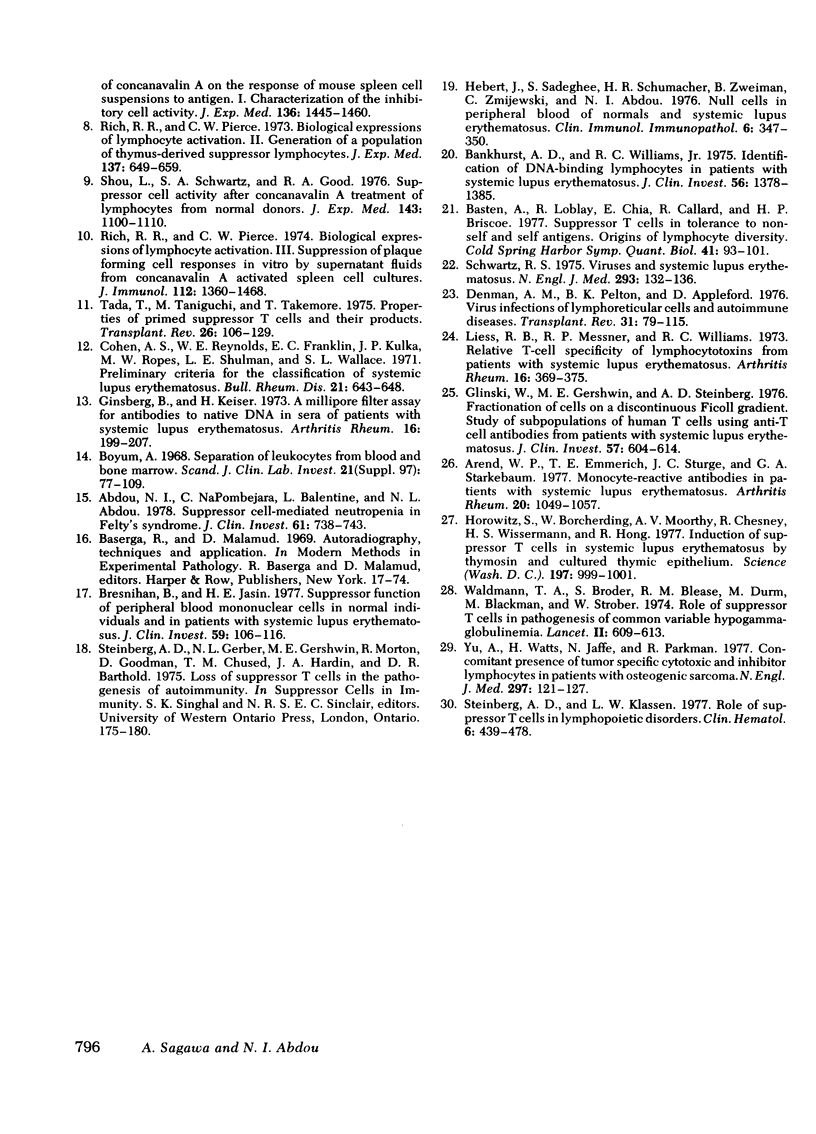
Selected References
These references are in PubMed. This may not be the complete list of references from this article.
- Abdou N. I., NaPombejara C., Balentine L., Abdou N. L. Suppressor cell-mediated neutropenia in Felty's syndrome. J Clin Invest. 1978 Mar;61(3):738–743. doi: 10.1172/JCI108987. [DOI] [PMC free article] [PubMed] [Google Scholar]
- Abdou N. I., Sagawa A., Pascual E., Hebert J., Sadeghee S. Suppressor T-cell abnormality in idiopathic systemic lupus erythematosus. Clin Immunol Immunopathol. 1976 Sep;6(2):192–199. doi: 10.1016/0090-1229(76)90110-0. [DOI] [PubMed] [Google Scholar]
- Allison A. C. The roles of T and B lymphocytes in self-tolerance and autoimmunity. Contemp Top Immunobiol. 1974;3:227–242. doi: 10.1007/978-1-4684-3045-5_9. [DOI] [PubMed] [Google Scholar]
- Arend W. P., Emmerich T. E., Sturge J. C., Starkebaum G. A. Monocyte-reactive antibodies in patients with systemic lupus erythematosus. Arthritis Rheum. 1977 Jun;20(5):1049–1057. doi: 10.1002/art.1780200503. [DOI] [PubMed] [Google Scholar]
- Bankhurst A. D., Williams R. C., Jr Cellular origins of autoantibody--a preplexing question. Am J Med. 1976 Sep;61(3):303–307. doi: 10.1016/0002-9343(76)90364-8. [DOI] [PubMed] [Google Scholar]
- Bankhurst A. D., Williams R. C., Jr Identification of DNA-binding lymphocytes in patients with systemic lupus erythematosus. J Clin Invest. 1975 Dec;56(6):1378–1385. doi: 10.1172/JCI108218. [DOI] [PMC free article] [PubMed] [Google Scholar]
- Basten A., Loblay R., Chia E., Callard R., Pritchard-Briscoe H. Suppressor T cells in tolerance to non-self and self antigens. Cold Spring Harb Symp Quant Biol. 1977;41(Pt 1):93–103. doi: 10.1101/sqb.1977.041.01.013. [DOI] [PubMed] [Google Scholar]
- Bresnihan B., Jasin H. E. Suppressor function of peripheral blood mononuclear cells in normal individuals and in patients with systemic lupus erythematosus. J Clin Invest. 1977 Jan;59(1):106–116. doi: 10.1172/JCI108607. [DOI] [PMC free article] [PubMed] [Google Scholar]
- Denman A. M., Pelton B. K., Appleford D., Kinsley M. Virus infections of lympho-reticular cells and auto-immune diseases. Transplant Rev. 1976;31:79–115. [PubMed] [Google Scholar]
- Dutton R. W. Inhibitory and stimulatory effects of concanavalin A on the response of mouse spleen cell suspensions to antigen. I. Characterization of the inhibitory cell activity. J Exp Med. 1972 Dec 1;136(6):1445–1460. doi: 10.1084/jem.136.6.1445. [DOI] [PMC free article] [PubMed] [Google Scholar]
- Ginsberg B., Keiser H. A Millipore filter assay for antibodies to native DNA in sera of patients with systemic lupus erythematosus. Arthritis Rheum. 1973 Mar-Apr;16(2):199–207. doi: 10.1002/art.1780160210. [DOI] [PubMed] [Google Scholar]
- Glinski W., Gershwin M. E., Steinberg A. D. Fractionation of cells on a discontinuous Ficoll gradient. Study of subpopulations of human T cells using anti-T-cell antibodies from patients with systemic lupus erythematosus. J Clin Invest. 1976 Mar;57(3):604–614. doi: 10.1172/JCI108316. [DOI] [PMC free article] [PubMed] [Google Scholar]
- Herbert J., Sadeghee S., Schumacher H. R., Zweiman B., Zmijewski C., Abdou N. I. Null cells in peripheral blood of normals and systemic lupus erythematosus. Clin Immunol Immunopathol. 1976 Nov;6(3):347–358. doi: 10.1016/0090-1229(76)90088-x. [DOI] [PubMed] [Google Scholar]
- Horowitz S., Borcherding W., Moorthy A. V., Chesney R., Schulte-Wisserman H., Hong R. Induction of suppressor T cells in systemic lupus erythematosus by thymosin and cultured thymic epithelium. Science. 1977 Sep 2;197(4307):999–1001. doi: 10.1126/science.302032. [DOI] [PubMed] [Google Scholar]
- Krakauer R. S., Strober W., Rippeon D. L., Waldmann T. A. Prevention of autoimmunity in experimental lupus erythematosus by soluble immune response suppressor. Science. 1977 Apr 1;196(4285):56–59. doi: 10.1126/science.300174. [DOI] [PubMed] [Google Scholar]
- Krakauer R. S., Waldmann T. A., Strober W. Loss of suppressor T cells in adult NZB/NZW mice. J Exp Med. 1976 Sep 1;144(3):662–673. doi: 10.1084/jem.144.3.662. [DOI] [PMC free article] [PubMed] [Google Scholar]
- Lies R. B., Messner R. P., Williams R. C., Jr Relative T-cell specificity of lymphocytotoxins from patients with systemic lupus erythematosus. Arthritis Rheum. 1973 May-Jun;16(3):369–375. doi: 10.1002/art.1780160312. [DOI] [PubMed] [Google Scholar]
- Mogensen C. E. The glomerular permeability determined by dextran clearance using Sephadex gel filtration. Scand J Clin Lab Invest. 1968;21(1):77–82. doi: 10.3109/00365516809076979. [DOI] [PubMed] [Google Scholar]
- Rich R. R., Pierce C. W. Biological expressions of lymphocyte activation. 3. Suppression of plaque-forming cell responses in vitro by supernatant fluids from concanavalin A-activated spleen cell cultures. J Immunol. 1974 Apr;112(4):1360–1368. [PubMed] [Google Scholar]
- Rich R. R., Pierce C. W. Biological expressions of lymphocyte activation. II. Generation of a population of thymus-derived suppressor lymphocytes. J Exp Med. 1973 Mar 1;137(3):649–659. doi: 10.1084/jem.137.3.649. [DOI] [PMC free article] [PubMed] [Google Scholar]
- Schwartz R. S. Virsues and systemic lupus erythematosus. N Engl J Med. 1975 Jul 17;293(3):132–136. doi: 10.1056/NEJM197507172930308. [DOI] [PubMed] [Google Scholar]
- Shou L., Schwartz S. A., Good R. A. Suppressor cell activity after concanavalin A treatment of lymphocytes from normal donors. J Exp Med. 1976 May 1;143(5):1100–1110. doi: 10.1084/jem.143.5.1100. [DOI] [PMC free article] [PubMed] [Google Scholar]
- Steinberg A. D., Klassen L. W. Role of suppressor T cells in lymphopoietic disorders. Clin Haematol. 1977 Jun;6(2):439–478. [PubMed] [Google Scholar]
- Tada T., Taniguchi M., Takemori T. Properties of primed suppressor T cells and their products. Transplant Rev. 1975;26:106–129. doi: 10.1111/j.1600-065x.1975.tb00177.x. [DOI] [PubMed] [Google Scholar]
- Talal N. Disordered immunologic regulation and autoimmunity. Transplant Rev. 1976;31:240–263. doi: 10.1111/j.1600-065x.1976.tb01456.x. [DOI] [PubMed] [Google Scholar]
- Waldmann T. A., Durm M., Broder S., Blackman M., Blaese R. M., Strober W. Role of suppressor T cells in pathogenesis of common variable hypogammaglobulinaemia. Lancet. 1974 Sep 14;2(7881):609–613. doi: 10.1016/s0140-6736(74)91940-0. [DOI] [PubMed] [Google Scholar]
- Yu A., Watts H., Jaffe N., Parkman R. Concomitant presence of tumor-specific cytotoxic and inhibitor lymphocytes in patients with osteogenic sarcoma. N Engl J Med. 1977 Jul 21;297(3):121–127. doi: 10.1056/NEJM197707212970301. [DOI] [PubMed] [Google Scholar]


